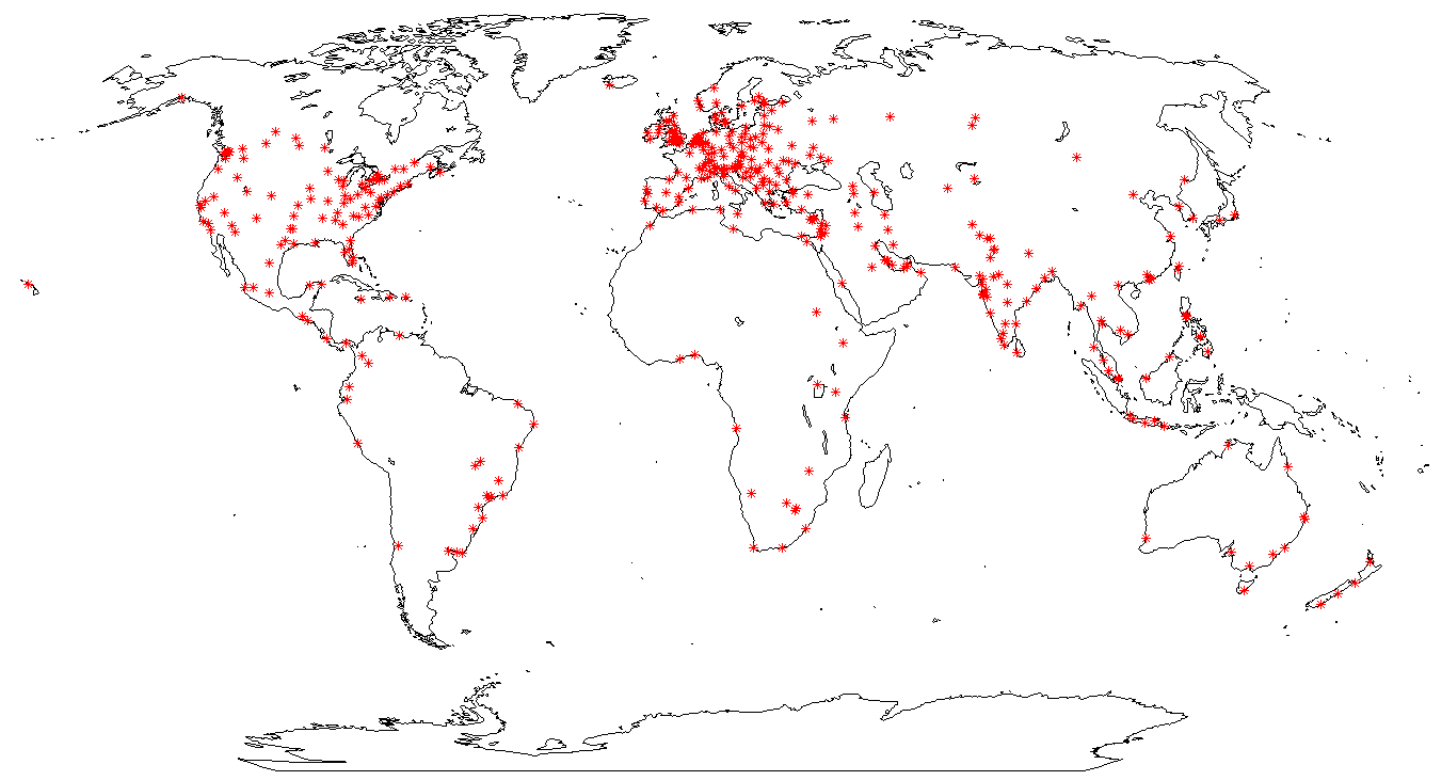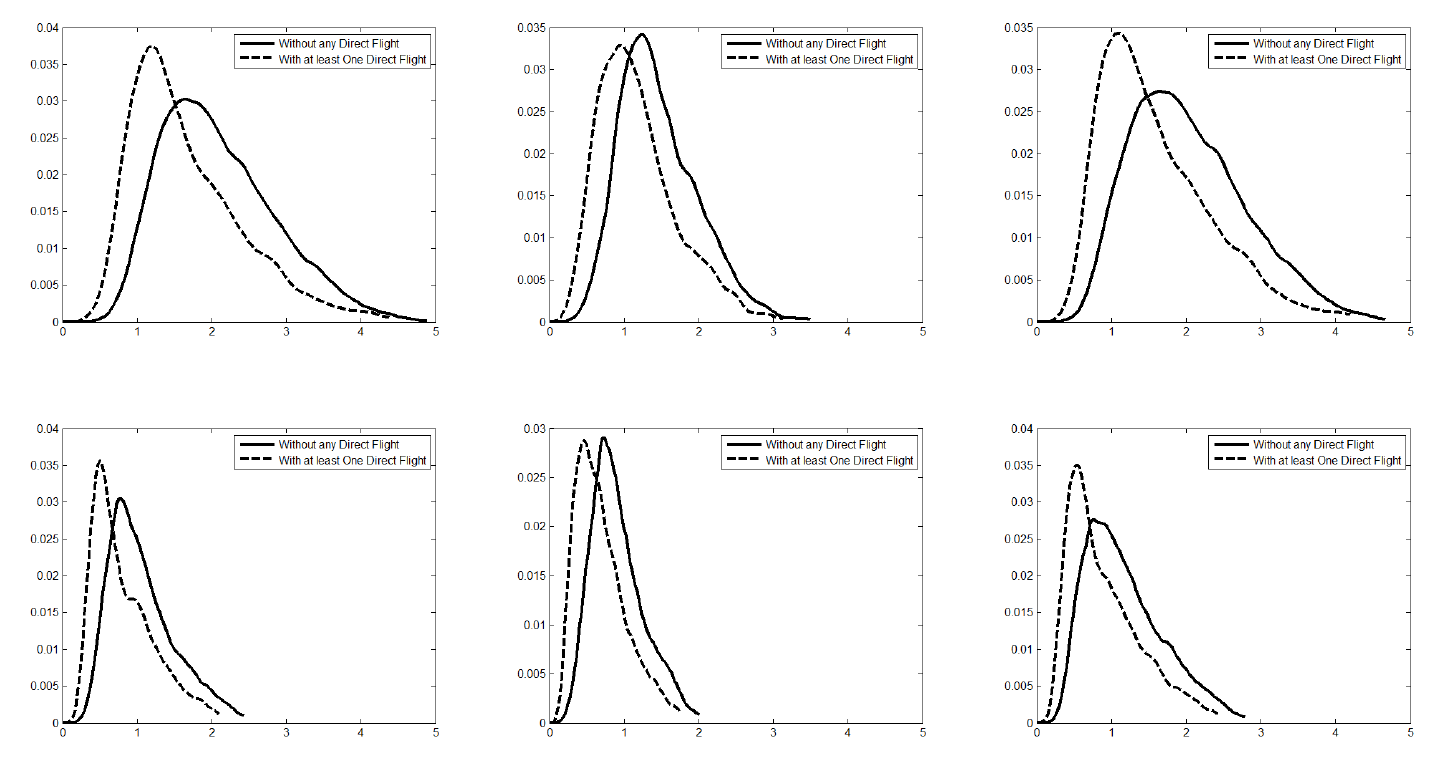
Federal Reserve Bank of Dallas
Globalization and Monetary Policy Institute
Working Paper No. 179
http://www.dallasfed.org/assets/documents/institute/wpapers/2014/0179.pdf
The Role of Direct Flights in Trade Costs
*
Demet Yilmazkuday
Florida International University
Hakan Yilmazkuday
Florida International University
May 2014
Abstract
The role of direct flights in trade costs is investigated by introducing and using a micro price
data set on 49 goods across 433 international cities covering 114 countries. It is shown that
having at least one direct flight reduces trade costs by about 1,400 miles in distance
equivalent terms, while an international border increases trade costs by about 14,907 miles;
hence, the positive effects of having at least one direct flight between any two cities can
compensate for about 10% of the negative effects of an average international border. Trade
costs also decrease with the number of direct flights: on average, one direct flight reduces
trade costs by about 305 miles in distance equivalent terms, which corresponds to 7% of the
average distance and can compensate for about 2% of the negative effects of an average
international border. The results are shown to be robust to alternative empirical strategies.
JEL codes: F15, F31
*
Demet Yilmazkuday, Department of Economics, Florida International University, Miami, FL 33199. 305-
Hakan Yilmazkuday, Department of Economics, Florida
International University, Miami, FL 33199. 305-348-2316. Hakan.yilmazkuday@fiu.edu. The views in this
paper are those of the authors and do not necessarily reflect the views of the Federal Reserve Bank of
Dallas or the Federal Reserve System.

1 Introduction
The increase in air transportation/travel due to the technological development in jet aircraft
engines has led to the improvement of global market integration signi…cantly since World
War II. This improvement has b een partly achieved by the increase in air shipment due to
lower air transportation costs,
1
and partly due to the face-to-face business meetings that
overcome informational asymmetries in international trade.
2
Besides the obvious role of
air transportation in the integration of the traded goods markets, air travel of individuals
has also contributed to the integration of non-traded goods markets, such as the housing
market and the service sector.
3
Therefore, there is no doubt that air transportation/travel
has signi…cantly contributed to welfare-improving globalization through reducing trade costs
between regions/countries.
Within this picture, direct ‡ights have gained more importance, because they provide the
cheapest and fastest air transp ortation/travel. For example, Alderighi and Gaggero (2012)
have found that the elasticity of exports to direct ‡ights is about 10%. Similarly, Micco and
1
Hummels (2007) shows that by the year of 2000, air shipments were representing a third of the value
of U.S. imports and more than half of U.S. exports with countries outside North America. Similarly, again
in 2000, excluding land neighbors, the air share of import value was more than 30 percent for Argentina,
Brazil, Colombia, Mexico, Paraguay, and Uruguay.
2
As Cristea (2011) and Poole (2013) have shown, business travel helps to overcome informational asym-
metries in international trade by generating international sales in the form of new export relationships.
3
For example, Ley and Tutchener (2001) show how house prices in Canadian cities are strongly associated
with overseas tourism. Moreover, service sectors such as medical tourism have bene…ted from the existence
of direct ‡ights b etween countries, as discussed in Bookman and Bookman (2007), Herrick (2007), and Helble
(2011).
1

Serebrisky (2006) have shown that Open Skies Agreements between countries, which allow
airlines to operate direct ‡ights internationally, reduce air transport costs by 9% and increase
by 7% the share of imports arriving by air. Moreover, studies such as Bel and Fageda (2008)
have found that the availability of direct ‡ights has a large in‡uence on the location of large
…rms’headquarters, which is another factor facilitating trade.
4
This paper attempts to measure the e¤ects of direct ‡ights on overall trade costs between
cities (in distance equivalent terms) by introducing and using a micro price data set on 49
goods across 433 international cities covering 114 countries. In the benchmark speci…cation,
following Eaton and Kortum (2002), together with other studies in which consumers search
for the minimum price across locations, we de…ne intercity trade costs as the maximum price
di¤erence (i.e., the maximum of deviations from the Law of One Price) across go ods between
two cities; for any city pair for which we compare micro prices, we also search for airports
within 50 miles to check whether they have any direct ‡ights between each other.
The benchmark results show that having at least one direct ‡ight corresponds to a re-
duction in trade costs by ab out 1,400 miles in distance equivalent terms, on average; this is
about one third of the average distance between the cities in the sample that is about 4,551
miles. Due to having both international and intranational city pairs, we also investigate
the role of an international border in trade costs: it is found that the average international
border increases trade costs by about 14,907 miles in distance equivalent terms, which is
about triple the average distance. In other words, the positive e¤ects of having at least one
direct ‡ight between any two cities can compensate for about 10% of the negative e¤ects
4
Regarding the importance of time spent in transportation, Hummels and Schaur (2013) estimate that
each day in transit is equivalent to an ad-valorem tari¤ of 0.6% to 2.3%.
2
of an average international border. Trade costs are also shown to be decreasing with the
number of direct ‡ights: the results show that one direct ‡ight reduces trade costs by about
305 miles, which is about 7% of the average distance; therefore, the positive e¤ects of one
direct ‡ight between any two cities can compensate for about 2% of the negative e¤ects of
an average international border.
For robustness, we consider many alternative empirical strategies. In order to measure
trade costs, for instance, we alternatively follow Borraz et al. (2012) who have suggested
using 80th, 90th or higher percentiles of micro price di¤erences in order to reduce the severity
of measurement errors in prices; on the other hand, we also follow Eaton and Kortum (2002)
by using the second maximum of the price di¤erence b etween cities. Since direct ‡ights can
be used for the air transportation of goods (i.e., for the market integration of traded goods)
or for the air travel of individuals (i.e., the market integration of non-traded goods, such
as housing and services, especially through tourism), we also consider the price di¤erence
between cities for both traded and non-traded goods in our sample. Finally, while searching
for a direct ‡ight between any two cities, we consider airports within 25, 100 and 200 miles
of the city centers. In all of these alternative empirical strategies, we …nd very similar results
in which the e¤ect of direct ‡ights on trade costs is always negative and signi…cant.
The rest of the paper is organized as follows. The next section introduces the empirical
methodology used to measure trade costs and details of the regression analysis. Section 3
depicts the data and descriptive statistics. Section 4 reveals the empirical results. Section 5
concludes.
3

2 Empirical Methodology
2.1 Measuring Trade Costs
Data for trade costs are either non-existing or not covering the globe.
5
Accordingly, studies
such as by Eaton and Kortum (2002), Simonovska and Waugh (2014), among many others,
have considered disaggregate price information across countries to measure trade costs. For
example, in Eaton and Kortum (2002), given a pair of countries, the maximum price dif-
ference across goods is used as a measure of trade costs. In order to understand the logic
behind this, consider the following arbitrage condition for the same good between any two
locations:
P
g
i
P
g
j
ji
(1)
where P
g
i
is the price of good g in location i, P
g
j
is the price of good g in location j, and
ji
represents the gross multiplicative trade costs from location j to location i. When traded
goods are considered, this expression literally means that importing good g from location
j is more costly compared to the already-available price in location i; therefore, this is
an expected situation in the equilibrium after arbitrage opportunities are taken (i.e., after
possible trade is achieved). When non-traded goods are considered, this expression means
that travelling from city i to city j to consume good g is more expensive than consuming the
same good in city i; the same arbitrage conditions are implied as for traded goods. Therefore,
5
An exception is the data set for the U.S. international trade that can be obtained from
http://dataweb.usitc.gov/. Nevertheless, even this detailed data set covers only the calculated duties and
the cost of all freight, insurance, and other charges incurred; it does n ot cover, for instance, trade costs due
to search frictions or time to ship.
4

in our empirical investigation, b elow, we will consider the implications for both traded and
non-traded goods.
The symmetric version of Equation 1 also holds with an inequality:
P
g
j
P
g
i
ij
When trade costs are symmetric (i.e., when
ji
=
ij
), the last two inequalities can be
combined in log terms as follows:
p
g
i
p
g
j
log
ij
where jj is the absolute operator, p
g
i
= log P
g
i
, and p
g
j
= log P
g
j
. The main point is that, when
the maximum (i.e., the upper bound) of the left hand side is considered, the last inequality
turns into an equality. For example, Eaton and Kortum (2002) consider the maximum of the
left hand side as the maximum price di¤erence across goods between two locations, which
can be summarized as follows:
log
ij
= max
g
p
g
i
p
g
j
(2)
We follow this de…nition of trade costs in our benchmark results.
As mentioned by Eaton and Kortum (2002) and Borraz et al. (2012), however, the maxi-
mum price di¤erence across goods is sensitive to the possibility of measurement errors in the
price data. Accordingly, Eaton and Kortum (2002) have considered the second maximum
price di¤erence across goods, while Borraz et al. (2012) have considered alternative per-
centiles (e.g., 80th, 90th, etc.). Therefore, besides our benchmark case de…ned as Equation
2, for robustness, we will also consider these alternative measures in our investigation.
5
2.2 Regression Analysis
Once trade costs are obtained (as described in the previous subsection), we are interested in
the e¤ects of having direct ‡ights between cities. Since we have data for the exact number
of direct ‡ights between cities, we will consider two alternative approaches.
In the …rst speci…cation, we consider the e¤ects of having at least one direct ‡ight between
cities. Accordingly, the following regression will be used (where the superscripts represent
the speci…cation):
log
ij
=
1
1
f
1
ij
+
1
2
b
ij
+
1
3
log d
ij
+ c
i
+ c
f
(3)
where f
1
ij
is a dummy variable taking a value of 1 when there is at least one direct ‡ight
between cities i and j, b
ij
is a dummy variable taking a value of 1 when there is an interna-
tional border between cities i and j, d
ij
is the great circle distance in miles between cities i
and j, c
i
and c
f
are city …xed e¤ects.
In the second speci…cation, we will consider the e¤ects of the number of direct ‡ights be-
tween cities, where we will employ the following regression (where the superscripts represent
the speci…cation):
log
ij
=
2
1
f
2
ij
+
2
2
b
ij
+
2
3
log d
ij
+ c
i
+ c
f
(4)
where f
2
ij
is the number of direct ‡ights between cities i and j, and the remaining notation
of variables is the same as in the …rst speci…cation, above.
In both speci…cations, the expected sign of
1
is negative since we expect that having
direct ‡ights between any considered city pair is going to reduce trade costs due to the
reduced search costs, informational asymmetries, time-to-ship, etc. As consistent with the
literature (e.g., Engel and Rogers, 1996), we also expect the e¤ects of international borders
6

and distance to be positive (i.e.,
2
> 0 and
3
> 0).
Using the estimated coe¢ cients, following the methodology introduced by Parsley and
Wei (2001), which is robust to the units of distance measurement used (e.g., miles versus
kilometers), the distance equivalent of having direct ‡ights can be measured by the following
expression:
F = d
ij
exp
1
3
1
(5)
while the distance equivalent of the average international border e¤ect can be measured by
the following expression:
B = d
ij
exp
2
3
1
(6)
where d
ij
is the average distance between cities, which is about 4,551 miles. In these expres-
sions, we literally determine the corresponding change in distance units to compansate for
having direct ‡ights or an international border.
3 Data and Descriptive Analysis
Micro price data include observations of 49 goods (22 traded and 27 non-traded) obtained
from 433 cities (covering 114 countries) for the years between 2010 and 2014. The com-
plete lists of goo ds and cities are given in Online Appendix tables, while the coverage of
cities are depicted on the world map in Figure 1, where we have multiple cities from many
countries. The data have been downloaded from http://www.numbeo.com/ which is the
world’s largest database of user contributed data about cities. Users of Numbeo can enter
the micro prices that they observe either at the good level or by using the price collection
sheet provided by the web page. Since the price data are user contributed, Numbeo uses
7

alternative metho dologies to …lter out noise data. First, the user provided data are checked
for outliers manually.
6
Second, one quarter of lowest and highest inputs are discarded as
borderline cases. Third, Numbeo uses heuristic technology that discards data which most
likely are incorrect statistically. Using the price data, we calculate log trade costs according
to Equation 2, where, as indicated in Table 1, the number of city pairs is 90,785, and number
of international city pairs are much higher than the number of intranational city pairs.
The data for direct ‡ights have been obtained from Airline Route Mapper for the year of
2013.
7
The data include information on 63,149 direct ‡ights from around the world where
the name of the airlines and airports are also provided. Considering the provided airport
codes and names, we determined the exact location of the airports (in terms of their latitudes
and longitudes) and the countries in which they are located by using Google Maps.
By using Google Maps, we also calculated the exact location of cities in our price data
(in terms of their latitudes and longitudes). Considering these locations, we calculated the
great circle distance between them in miles to be used in the regression analysis (see Table
1). Furthermore, in order to determine whether there is a direct ‡ight between any two cities
in our price data, we searched for the airports within 50 miles of the city centers by using the
airport location data we have. We found that for some cities, there are no airports within
50 miles, while for some others, there are more than one airp ort; summary statistics are
provided in Table 1 where the number of direct ‡ights is 10,677 (out of 90,785). For a given
city pair for which prices are compared, we calculated the number of direct ‡ights using the
6
For example, for a particular price in a city, when values contributed are 5, 6, 20, and 4 in a reasonable
time span, the value of 20 is discarded as a noise.
7
The web page is http://arm.64hosts.com/.
8

direct ‡ight data that we have by considering all available airports within 50 miles. In the
empirical investigation, we consider two alternative versions of this information: (i) having
at least one direct ‡ight between cities, and (ii) the exact number of direct ‡ights between
cities.
8
For robustness, we also considered alternative measures of proximity to the airport
(i.e., airp orts within 25, 100, and 200 miles of city centers); in Table 1, to save space, we
only depict the summary statistics for airports within 100 miles of city centers.
When the maximum price di¤erence across goods is used as the measure of trade costs
between cities and airports within 50 miles of city centers are considered to determine direct
‡ights, the corresponding Kernel density estimates are provided in the upper panel of Figure
2, where the city pairs that have a direct ‡ight between each other have fewer trade costs
between each other, independent of considering traded or non-traded goods. The results
remain the same with a di¤erent magnitude when the 80th percentile of price di¤erence
across goods is used as the measure of trade costs between cities, as depicted in the lower
panel of Figure 2. Therefore, direct ‡ights seems to have a reducing e¤ect on trade costs
between cities. Nevertheless, proving this claim requires a formal investigation, of which
results we depict next.
4 Empirical Results
When the maximum price di¤erence across all goods is used as the measure of trade costs
between cities and airports within 50 miles of city centers are considered to determine direct
8
The exact number of direct ‡ights is de…ned as one ‡ight in any direction between the considered cities.
For example, an airline serving between two cities inbound and outbound is considered as two di¤erent
‡ights.
9

‡ights, the results in Table 2 are obtained for the estimation of Equation 3. As is evident, all
considered variables are signi…cant at the 1% level, and the adjusted R-bar squared values
are as high as 0.67 when city …xed e¤ects are included. The main point out of these results is
the negative and signi…cant coe¢ cient estimate of the dummy for having at least one direct
‡ight between the considered cities; this result holds for all eight alternative regressions in
Table 2.
We would like to focus on regression version (4) in Table 2, since it includes all the
considered variables in Equation 3. The distance-equivalent e¤ects of having at least one
direct ‡ight, calculated according to Equation 5, are about 1; 400 miles, while the distance-
equivalent e¤ects of borders, calculated according to Equation 6, are about 14; 907 miles.
9
Therefore, the positive e¤ects of having at least one direct ‡ight between any international
city pair can compensate for the negative e¤ects of a border by about 10%, on average across
all cities in our sample. When distance elasticity of trade is about one, which is the most
commonly estimated coe¢ cient of log distance in gravity studies (e.g., see Disdier and Head,
2008), this result is comparable to the results in Alderighi and Gaggero (2012) who have
found that the elasticity of exports to direct ‡ights is about 10%. Since the average distance
between the cities in our sample is about 4; 551 miles (according to Table 1), we can safely
claim that the e¤ect of borders are about triple the e¤ects of distance, while having at least
9
In order to compare this number with the existing literature, consider the following studies that have
used alternative data sets and empirical methodologies: Among many others, Engel and Rogers (1996) have
estimated the distance equivalent of the U.S.-Canada border about 75,000 miles; Parsley and Wei (2001)
have estimated the U.S.-Japan border about 43 000 trillion miles; Yilmazkuday (2012) has estimated the
average border across states of the U.S. about 3,344 miles.
10
one direct ‡ight reduces the e¤ects of distance by one third.
When we replicate the results in Table 2 using price data on traded goods only, we obtain
the results in Table 3, where the signi…cance and signs of all variables remain the same.
When we consider the implied distance-equivalent e¤ects, according regression version (4),
having at least one direct ‡ight corresponds to about 1; 000 miles, while having a border
corresponds to about 25; 870 miles. Hence, having at least one direct ‡ight between any
international city pair reduces the e¤ects of a border by about 4%, on average across all
cities in our sample, when price data on traded goods only are considered.
When Equation 4 is estimated to investigate the e¤ects of the number of direct ‡ights on
trade costs, the results in Table 2 are replaced by the results in Table 4, where the maximum
price di¤erence across all goods is considered as the measure of trade costs, and airports
within 50 miles of city centers are considered to determine direct ‡ights. As is evident,
again, all considered variables have their expected signs and they are signi…cant at the 1%
level. Having one direct ‡ight reduces trade costs by about 305 miles in distance equivalent
terms, on average; hence, an airline serving both an inbound and an outbound ‡ight between
two cities reduces trade costs by about 710 (= 350 2) miles in distance equivalent terms.
The interesting part of this result is that trade costs are reduced further as the number of
direct ‡ights increases. When we replicate the results in Table 4 by using price data on
traded goo ds only, we obtain the results in Table 5, where one direct ‡ight reduces trade
costs by ab out 241 miles in distance equivalent terms, on average.
We considered many alternative estimation strategies for robustness. These include repli-
cating Tables 2-4 by (i) using price data on non-traded goods only, (ii) considering the second
maximum of price di¤erence across goods between cities as the measure of trade costs, (iii)
11

considering the 80th percentile of price di¤erence across goods between cities as the mea-
sure of trade costs, and (iv) considering airp orts within 100 miles of city centers. All of
these investigations resulted in virtually similar results (i.e., direct ‡ights a¤ect trade costs
negatively and signi…cantly), which can be found in the Online Appendix of this paper.
10
5 Conclusion
The e¤ects of direct ‡ights on trade costs have been shown to be negative and signi…cant
across cities around the world. Having at least one direct ‡ight corresponds to a reduction
in trade costs by about 1,400 miles in distance equivalent terms, on average, which is about
one third of the average distance between cities. The results also show that one direct ‡ight
reduces trade costs by about 305 miles, which is about 7% of the average distance. Since
the average international b order is shown to increase trade costs by about 14,907 miles, the
positive e¤ects of having at least one direct ‡ight (respectively, having one direct ‡ight)
between any two cities can compensate for about 10% (respectively, 2%) of the negative
e¤ects of an average international border. Therefore, the results, which are supported by
many alternative robustness analyses, are in favor of international policies such as Open
Skies Agreements that facilitate direct ‡ights and thus reduce trade costs.
The results, for sure, depend on the focus of this paper, which is about the e¤ects of direct
‡ights; alternatively, indirect ‡ights may also be contributing to the reduction of trade costs.
However, indirect ‡ights are hard to measure/capture due to the many alternative routes
10
Many other alternative measu res can also be investigated by u sing the to-be-published Matlab codes of
this paper.
12
that one can have; e.g., from New York City, USA to Istanbul, Turkey, there are many
alternative airline routes that one can use regarding indirect ‡ights. Such indirect e¤ects,
nevertheless, can be investigated by considering the network e¤ects of direct ‡ights across
cities, although it is out of the scope of this paper.
References
[1] Alderighi, M. and Gaggero, A. (2012) "Do non-stop ‡ights boost exports?," mimeo.
[2] Bel, G. and Fageda, X., (2008), "Getting there fast: globalization, intercontinental
‡ights and location of headquarters," Journal of Economic Geography, 8(4): 471-495.
[3] Borraz, F., Cavallo, A., Rigobon, R. and Zipitría, L., (2012) "Distance and Political
Boundaries: Estimating Border E¤ects under Inequality Constraints," mimeo.
[4] Cristea, A.D. (2011) "Buyer-seller relationships in international trade: Evidence from
U.S. States’exports and business-class travel," Journal of International Economics, 84:
207–220.
[5] Disdier, A.C. and Head, K. (2008) "The puzzling persistence of the distance exoect on
bilateral trade," The Review of Economics and Statistics 90(1): 37–41.
[6] Eaton, J. and Kortum, S. (2002) "“Technology, Geography, and Trade,”Econometrica,
70(5), 1741–1779.
[7] Engel, C., Rogers, J, (1996), "How wide is the border?" American Economic Review,
86: 1112–1125.
13
[8] Helble, M. (2011) "The movement of patients across borders: Challenges and opportu-
nities for public health," Bulletin of the World Health Organization, 89: 68–72.
[9] Herrick, D.M. (2007), "Medical Tourism: Global Competition in Health Care," National
Center for Policy Analysis, Policy Report No. 304.
[10] Hummels, D., (2007) "Transportation Costs and International Trade in the Second Era
of Globalization," Journal of Economic Perspectives, 21(3): 131-154.
[11] Hummels, D.L. and Schaur, G., (2013) "Time as a Trade Barrier," American Economic
Review, 103(7): 2935-2959.
[12] Ley, D. and Tutchener, J. (2001) “Immigration, Globalisation and House Prices in
Canada’s Gateway Cities,”Housing Studies, 16: 199-223.
[13] Micco, A. and Serebrisky, T. (2006). "Competition Regimes and Air Transport Costs:
The e¤ects of open skies agreements," Journal of International Economics, 70: 25–51.
[14] Parsley, D.C.,Wei, S.-J., (2001), "Explaining the border e¤ect: the role of exchange rate
variability, shipping costs, and geography," Journal of International Economics, 55(1):
87–105.
[15] Poole,J.P. (2013) "Business Travel as an Input to International Trade," mimeo.
[16] Simonovska, I. and Waugh, M.E., (2014) "The elasticity of trade: Estimates and evi-
dence," Journal of International Economics, 92(1): 34-50.
[17] Yilmazkuday,H. (2012), "How wide is the border across U.S. states?" Letters in Spatial
and Resource Sciences, 5:25–31.
14

Figure 1 - Cities in the Micro Price Data
Notes: Each star represents a city in the micro price data. There are 433 cities in the sample.

Figure 2 - Kernel Density of Price Dispersion across Cities
Maximum Price Difference across All Goods
Maximum Price Difference across Traded Goods
Maximum Price Difference across Non-Traded Goods
80th Prctile of Price Difference across All Goods
80th Prctile Price of Difference across Traded Goods
80th Prctile of Price Difference across Non-Traded Goods
Notes: For any given city pair and each good, the price difference is first calculated as the absolute log price difference. Afterwards, for each city pair, the
maximum or the 80th percentile of these price differences are calculated across goods. City pairs with direct flights are defined as the pairs that have at least one
direct flight between each other through an airport within 50 miles of the center city. The sample size is 90,785.

Table 1 - Descriptive Statistics
All City Pairs International City Pairs Intranational City Pairs
Number of City Pairs in Price Data 90,785 87,346 3,439
City Pairs that have at least One Direct Flight
through an Airport within 50 Miles
10,677 8,819 1,858
City Pairs that have at least One Direct Flight
through an Airport within 100 Miles
17,135 14,703 2,432
Average Distance in Miles 4,551 4,692 980
Source: International city pairs are defined as the pairs that have an international border between them. Intranational city pairs are defined as the pairs that are
located in the same country. The availability of the price data has been determined by considering the long-run relative prices between 2010-2014. The availability
of the direct flights has been determined according to the data for 2013.

Table 2 - Effects of Having at Least One Direct Flight on the Maximum Price Difference (across All Goods) through an Airport within 50 Miles
Variables Dependent Variable: Maximum (across All Goods) of Absolute Log Price Difference between Cities
(1) (2) (3) (4) (5) (6) (7) (8)
Dummy for Having at Least
One Direct Flight
-0.37***
-0.09***
-0.08***
-0.43***
-0.18***
-0.14***
(0.01)
(0.01)
(0.01)
(0.01)
(0.01)
(0.01)
[0.00]
[0.00]
[0.00]
[0.00]
[0.00]
[0.00]
Log Distance
0.24***
0.21***
0.20***
0.22***
0.21***
0.19***
(0.00)
(0.00)
(0.00)
(0.00)
(0.00)
(0.00)
[0.00]
[0.00]
[0.00]
[0.00]
[0.00]
[0.00]
Border Dummy
0.31***
0.30***
0.51***
0.47***
(0.01)
(0.01)
(0.02)
(0.02)
[0.00]
[0.00]
[0.00]
[0.00]
Distance-Equivalent Effects
of Having at Least One Direct
Flight in Miles
-1,498 -1,400 -2,561 -2,385
Distance-Equivalent Effects
of Borders in Miles
14,817 14,907 49,206 51,555
City Fixed Effects YES YES YES YES NO NO NO NO
R-Squared 0.63 0.67 0.67 0.67 0.02 0.06 0.07 0.07
Notes: *, **, and *** represent significance at the 10%, 5%, and 1% levels, respectively. Standard errors are in parenthesis and p-values are in brackets. All
regressions include a constant that are not shown.

Table 3 - Effects of Having at Least One Direct Flight on the Maximum Price Difference (across Traded Goods) through an Airport within 50 Miles
Variables Dependent Variable: Maximum (across Traded Goods) of Absolute Log Price Difference between Cities
(1) (2) (3) (4) (5) (6) (7) (8)
Dummy for Having at Least
One Direct Flight
-0.29***
-0.06***
-0.04***
-0.29***
-0.13***
-0.09***
(0.00)
(0.00)
(0.01)
(0.01)
(0.01)
(0.01)
[0.00]
[0.00]
[0.00]
[0.00]
[0.00]
[0.00]
Log Distance
0.20***
0.17***
0.16***
0.14***
0.12***
0.11***
(0.00)
(0.00)
(0.00)
(0.00)
(0.00)
(0.00)
[0.00]
[0.00]
[0.00]
[0.00]
[0.00]
[0.00]
Border Dummy
0.32***
0.31***
0.53***
0.51***
(0.01)
(0.01)
(0.02)
(0.02)
[0.00]
[0.00]
[0.00]
[0.00]
Distance-Equivalent Effects
of Having at Least One Direct
Flight in Miles
-1,207 -1,000 -2,743 -2,491
Distance-Equivalent Effects
of Borders in Miles
25,339 25,870 383,948 484,132
City Fixed Effects YES YES YES YES NO NO NO NO
R-Squared 0.64 0.68 0.69 0.69 0.02 0.05 0.07 0.07
Notes: *, **, and *** represent significance at the 10%, 5%, and 1% levels, respectively. Standard errors are in parenthesis and p-values are in brackets. All
regressions include a constant that are not shown.

Table 4 - Effects of the Number of Direct Flights on the Maximum Price Difference (across All Goods) through an Airport within 50 Miles
Variables Dependent Variable: Maximum (across All Goods) of Absolute Log Price Difference between Cities
(1) (2) (3) (4) (5) (6) (7) (8)
Number of Direct Flights
-0.04***
-0.02***
-0.01***
-0.05***
-0.02***
-0.02***
(0.00)
(0.00
(0.00)
(0.00)
(0.00)
(0.00)
[0.00]
[0.00]
[0.00]
[0.00]
[0.00]
[0.00]
Log Distance
0.23***
0.21***
0.20***
0.22***
0.21***
0.19***
(0.00)
(0.00)
(0.00)
(0.00)
(0.00)
(0.00)
[0.00]
[0.00]
[0.00]
[0.00]
[0.00]
[0.00]
Border Dummy
0.31***
0.29***
0.51***
0.46***
(0.01)
(0.01)
(0.02)
(0.02)
[0.00]
[0.00]
[0.00]
[0.00]
Distance-Equivalent Effects
of One Direct Flight in Miles
-305 -305 -476 -434
Distance-Equivalent Effects
of Borders in Miles
14,817 14,479 49,206 46,791
City Fixed Effects YES YES YES YES NO NO NO NO
R-Squared 0.63 0.67 0.67 0.67 0.02 0.07 0.07 0.07
Notes: *, **, and *** represent significance at the 10%, 5%, and 1% levels, respectively. Standard errors are in parenthesis and p-values are in brackets. All
regressions include a constant that are not shown.

Table 5 - Effects of the Number of Direct Flights on the Maximum Price Difference (across Traded Goods) through an Airport within 50 Miles
Variables Dependent Variable: Maximum (across Traded Goods) of Absolute Log Price Difference between Cities
(1) (2) (3) (4) (5) (6) (7) (8)
Number of Direct Flights
-0.03***
-0.01***
-0.01***
-0.03***
-0.02***
-0.01***
(0.00)
(0.00
(0.00)
(0.00)
(0.00)
(0.00)
[0.00]
[0.00]
[0.00]
[0.00]
[0.00]
[0.00]
Log Distance
0.19***
0.17***
0.16***
0.14***
0.12***
0.11***
(0.00)
(0.00)
(0.00)
(0.00)
(0.00)
(0.00)
[0.00]
[0.00]
[0.00]
[0.00]
[0.00]
[0.00]
Border Dummy
0.32***
0.30***
0.53***
0.50***
(0.01)
(0.01)
(0.01)
(0.01)
[0.00]
[0.00]
[0.00]
[0.00]
Distance-Equivalent Effects
of One Direct Flight in Miles
-252 -241 -561 -507
Distance-Equivalent Effects
of Borders in Miles
25,339 25,563 383,948 430,132
City Fixed Effects YES YES YES YES NO NO NO NO
R-Squared 0.64 0.68 0.69 0.69 0.02 0.06 0.07 0.07
Notes: *, **, and *** represent significance at the 10%, 5%, and 1% levels, respectively. Standard errors are in parenthesis and p-values are in brackets. All
regressions include a constant that are not shown.

Online Appendix (Not For Publication)
Table A.1 - Goods in the Micro Price Data
Good Code
Goods
Traded Goods
1
Meal, Inexpensive Restaurant
0
2
Meal for 2, Mid-range Restaurant, Three-course
0
3
Combo Meal at McDonalds or Similar
0
4
Domestic Beer (0.5 liter draught)
0
5
Imported Beer (0.33 liter bottle)
1
6
Coke/Pepsi (0.33 liter bottle)
1
7
Water (0.33 liter bottle)
1
8
Milk (regular), (1 liter)
1
9
Loaf of Fresh White Bread (500g)
0
10
Eggs (12)
1
11
Local Cheese (1kg)
0
12
Water (1.5 liter bottle)
1
13
Bottle of Wine (Mid-Range)
1
14
Domestic Beer (0.5 liter bottle)
0
15
Imported Beer (0.33 liter bottle)
1
16
Pack of Cigarettes (Marlboro)
1
17
One-way Ticket (Local Transport)
0
18
Chicken Breasts (Boneless, Skinless), (1kg)
1
19
Monthly Pass (Regular Price)
0
20
Gasoline (1 liter)
1
21
Volkswagen Golf 1.4 90 KW Trendline (Or Equivalent New Car)
1
22
Apartment (1 bedroom) in City Centre
0
23
Apartment (1 bedroom) Outside of Centre
0
24
Apartment (3 bedrooms) in City Centre
0
25
Apartment (3 bedrooms) Outside of Centre
0
26
Basic (Electricity, Heating, Water, Garbage) for 85m2 Apartment
0
27
1 min. of Prepaid Mobile Tariff Local (No Discounts or Plans)
0
28
Internet (6 Mbps, Unlimited Data, Cable/ADSL)
0
29
Fitness Club, Monthly Fee for 1 Adult
0
30
Tennis Court Rent (1 Hour on Weekend)
0
31
Cinema, International Release, 1 Seat
0
32
1 Pair of Jeans (Levis 501 Or Similar)
1
33
1 Summer Dress in a Chain Store (Zara, H&M, ...)
1
34
1 Pair of Nike Shoes
1
35
1 Pair of Men Leather Shoes
1
36
Price per Square Meter to Buy Apartment in City Centre
0
37
Price per Square Meter to Buy Apartment Outside of Centre
0
38
Average Monthly Disposable Salary (After Tax)
0
39
Mortgage Interest Rate in Percentages (%), Yearly
0
40
Taxi Start (Normal Tariff)
0
41
Taxi 1km (Normal Tariff)
0
42
Taxi 1hour Waiting (Normal Tariff)
0
43
Apples (1kg)
1
44
Oranges (1kg)
1
45
Potato (1kg)
1
46
Lettuce (1 head)
1
47
Cappuccino (regular)
0
48
Rice (white), (1kg)
1
49
Tomato (1kg)
1
Notes: Traded goods take a value of 1 in the last column.

Online Appendix (Not For Publication)
Table A.2 - Cities in the Micro Price Data
City
City
City
City
City
City
City
City
City
Aachen, Germany
Bhopal, India
Cologne, Germany
Grenoble, France
Kota Kinabalu, Malaysia
Milton Keynes, United Kingdom
Phnom Penh, Cambodia
Sao Jose dos Campos, Brazil
Tunis, Tunisia
Aalborg, Denmark
Bhubenswar, India
Colombo, Sri Lanka
Groningen, Netherlands
Kowloon, Hong Kong
Milwaukee, WI, United States
Phoenix, AZ, United States
Sao Paulo, Brazil
Turin, Italy
Abbotsford, Canada
Bialystok, Poland
Columbus, OH, United States
Guadalajara, Mexico
Krakow (Cracow), Poland
Minneapolis, MN, United States
Phuket, Thailand
Sarajevo, Bosnia And Herzegovina
Turku, Finland
Aberdeen, United Kingdom
Bilbao, Spain
Copenhagen, Denmark
Guangzhou, China
Kuala Lumpur, Malaysia
Minsk, Belarus
Pittsburgh, PA, United States
Saskatoon, Canada
Ulaanbaatar, Mongolia
Abu Dhabi, United Arab Emirates
Birmingham, United Kingdom
Cork, Ireland
Guatemala City, Guatemala
Kuching, Malaysia
Mississauga, Canada
Plovdiv, Bulgaria
Seattle, WA, United States
Utrecht, Netherlands
Accra, Ghana
Bogota, Colombia
Coventry, United Kingdom
Guildford, United Kingdom
Kuwait City, Kuwait
Monterrey, Mexico
Port Elizabeth, South Africa
Seoul, South Korea
Vadodara, India
Ad Dammam, Saudi Arabia
Boise, ID, United States
Cuenca, Ecuador
Gurgaon, India
Lagos, Nigeria
Montevideo, Uruguay
Portland, OR, United States
Sevilla, Spain
Valencia, Spain
Addis Ababa, Ethiopia
Bologna, Italy
Curitiba, Brazil
Haifa, Israel
Lahore, Pakistan
Montreal, Canada
Porto Alegre, Brazil
Shanghai, China
Vancouver, Canada
Adelaide, Australia
Bordeaux, France
Dallas, TX, United States
Halifax, Canada
Larnaca, Cyprus
Moscow, Russia
Porto, Portugal
Sharjah, United Arab Emirates
Varna, Bulgaria
Ahmedabad, India
Boston, MA, United States
Damascus, Syria
Hamburg, Germany
Las Vegas, NV, United States
Mumbai, India
Poznan, Poland
Shenzhen, China
Venice, Italy
Akron, OH, United States
Brampton, Canada
Dar Es Salaam, Tanzania
Hamilton, Canada
Lausanne, Switzerland
Munich, Germany
Prague, Czech Republic
Shiraz, Iran
Verona, Italy
Albuquerque, NM, United States
Brasilia, Brazil
Darwin, Australia
Hanoi, Vietnam
Leeds, United Kingdom
Muscat, Oman
Pretoria, South Africa
Singapore, Singapore
Vicenza, Italy
Alexandria, Egypt
Brasov, Romania
Davao, Philippines
Harare, Zimbabwe
Leicester, United Kingdom
Nagpur, India
Pristina, Serbia
Skopje, Macedonia
Victoria, Canada
Algiers, Algeria
Bratislava, Slovakia
Delhi, India
Hartford, CT, United States
Leiden, Netherlands
Nairobi, Kenya
Puerto Vallarta, Mexico
Sliema, Malta
Vienna, Austria
Alicante, Spain
Brighton, United Kingdom
Denver, CO, United States
Helsinki, Finland
Lille, France
Nanaimo, BC, Canada
Pune, India
Sofia, Bulgaria
Vilnius, Lithuania
Almaty, Kazakhstan
Brisbane, Australia
Detroit, MI, United States
Ho Chi Minh City, Vietnam
Lima, Peru
Naples, Italy
Punta del Este, Uruguay
Split, Croatia
Visakhapatnam, India
Amman, Jordan
Bristol, United Kingdom
Dhaka, Bangladesh
Hobart, Australia
Limassol, Cyprus
Nashville, TN, United States
Quebec City, Canada
Spokane, WA, United States
Vladivostok, Russia
Amsterdam, Netherlands
Brno, Czech Republic
Dnipropetrovsk, Ukraine
Hong Kong, Hong Kong
Lisbon, Portugal
Nasik, India
Quezon City, Philippines
Stavanger, Norway
Warsaw, Poland
Anchorage, AK, United States
Brussels, Belgium
Doha, Qatar
Honolulu, HI, United States
Liverpool, United Kingdom
Navi Mumbai, India
Quito, Ecuador
Stockholm, Sweden
Washington, DC, United States
Ankara, Turkey
Bucharest, Romania
Donetsk, Ukraine
Houston, TX, United States
Ljubljana, Slovenia
New Orleans, LA, United States
Raleigh, NC, United States
Strasbourg, France
Waterloo, Canada
Antalya, Turkey
Budapest, Hungary
Dresden, Germany
Huntsville, AL, United States
Lodz, Poland
New York, NY, United States
Reading, United Kingdom
Stuttgart, Germany
Wellington, New Zealand
Antwerp, Belgium
Buenos Aires, Argentina
Dubai, United Arab Emirates
Hyderabad, India
London, Canada
Newcastle Upon Tyne, United Kingdom
Recife, Brazil
Surabaya, Indonesia
West Palm Beach, FL, United States
Arhus, Denmark
Buffalo, NY, United States
Dublin, Ireland
Iasi, Romania
London, United Kingdom
Nice, France
Regina, Canada
Surat, India
Wichita, KS, United States
Asheville, NC, United States
Bursa, Turkey
Dunedin, New Zealand
Indianapolis, IN, United States
Los Angeles, CA, United States
Nicosia, Cyprus
Reno, NV, United States
Surrey, Canada
Windhoek, Namibia
Athens, Greece
Busan, South Korea
Durban, South Africa
Indore, India
Louisville, KY, United States
Nis, Serbia
Reykjavik, Iceland
Sydney, Australia
Windsor, Canada
Atlanta, GA, United States
Bydgoszcz, Poland
Dusseldorf, Germany
Irbil, Iraq
Luanda, Angola
Nizhniy Novgorod, Russia
Richmond, VA, United States
Szczecin, Poland
Winnipeg, Canada
Auckland, New Zealand
Cairns, Australia
Edinburgh, United Kingdom
Islamabad, Pakistan
Lublin, Poland
Noida, India
Riga, Latvia
Taichung, Taiwan
Wroclaw, Poland
Austin, TX, United States
Cairo, Egypt
Edmonton, Canada
Istanbul, Turkey
Ludhiana, India
Nottingham, United Kingdom
Rijeka, Croatia
Taipei, Taiwan
Yangon, Myanmar
Baghdad, Iraq
Calgary, Canada
Eindhoven, Netherlands
Izmir, Turkey
Lugano, Switzerland
Novi Sad, Serbia
Rio De Janeiro, Brazil
Tallinn, Estonia
Yekaterinburg, Russia
Bahrain, Bahrain
Cambridge, United Kingdom
Esfahan, Iran
Jacksonville, FL, United States
Luxembourg, Luxembourg
Novosibirsk, Russia
Riyadh, Saudi Arabia
Tampa, FL, United States
Yerevan, Armenia
Baku, Azerbaijan
Campinas, Brazil
Espoo, Finland
Jaipur, India
Lviv, Ukraine
Nuremberg, Germany
Roanoke, VA, United States
Tampere, Finland
Yogyakarta, Indonesia
Bali, Indonesia
Canberra, Australia
Florence, Italy
Jakarta, Indonesia
Lyon, France
Odesa, Ukraine
Rochester, NY, United States
Tartu, Estonia
Zagreb, Croatia
Baltimore, MD, United States
Cancun, Mexico
Florianopolis, Brazil
Jeddah (Jiddah), Saudi Arabia
Macao, Macao
Oklahoma City, OK, United States
Rome, Italy
Tashkent, Uzbekistan
Zurich, Switzerland
Bandung, Indonesia
Cape Town, South Africa
Fort Lauderdale, FL, United States
Jerusalem, Israel
Madison, WI, United States
Omaha, NE, United States
Rostov-na-donu, Russia
Tbilisi, Georgia
Bangalore, India
Caracas, Venezuela
Fort Worth, TX, United States
Johannesburg, South Africa
Madrid, Spain
Orlando, FL, United States
Rotterdam, Netherlands
Tehran, Iran
Bangkok, Thailand
Cardiff, United Kingdom
Fortaleza, Brazil
Johor Baharu, Malaysia
Makati, Philippines
Osaka, Japan
Sacramento, CA, United States
Tel Aviv-Yafo, Israel
Banja Luka, Bosnia And Herzegovina
Casablanca, Morocco
Frankfurt, Germany
Kampala, Uganda
Malaga, Spain
Osijek, Croatia
Saint Louis, MO, United States
Thane, India
Barcelona, Spain
Cebu, Philippines
Fredericton, Canada
Kansas City, MO, United States
Malmo, Sweden
Oslo, Norway
Saint Petersburg, Russia
The Hague, Netherlands
Barrie, Canada
Chandigarh, India
Gaborone, Botswana
Karachi, Pakistan
Manama, Bahrain
Ottawa, Canada
Salt Lake City, UT, United States
Thessaloniki, Greece
Basel, Switzerland
Charlotte, NC, United States
Galway, Ireland
Kathmandu, Nepal
Manchester, United Kingdom
Oxford, United Kingdom
Salvador, Brazil
Thiruvananthapuram, India
Beersheba, Israel
Chennai, India
Gdansk, Poland
Katowice, Poland
Manila, Philippines
Padova, Italy
San Antonio, TX, United States
Timisoara, Romania
Beijing, China
Chiang Mai, Thailand
Geneva, Switzerland
Kaunas, Lithuania
Maribor, Slovenia
Panama City, Panama
San Diego, CA, United States
Tirana, Albania
Beirut, Lebanon
Chicago, IL, United States
Genoa, Italy
Kelowna, Canada
Marseille, France
Paphos, Cyprus
San Francisco, CA, United States
Tokyo, Japan
Belfast, United Kingdom
Chisinau, Moldova
Gent, Belgium
Kharkiv, Ukraine
Medellin, Colombia
Paris, France
San Jose, CA, United States
Tomsk, Russia
Belgrade, Serbia
Christchurch, New Zealand
Glasgow, United Kingdom
Khartoum, Sudan
Melbourne, Australia
Patras, Greece
San Jose, Costa Rica
Toronto, Canada
Belo Horizonte, Brazil
Cincinnati, OH, United States
Goa, India
Kiev, Ukraine
Memphis, TN, United States
Pattaya, Thailand
San Juan, Puerto Rico
Toulouse, France
Bergamo, Italy
Cleveland, OH, United States
Goiania, Brazil
Kingston, Jamaica
Merida, Mexico
Penang, Malaysia
San Salvador, El Salvador
Trieste, Italy
Bergen, Norway
Cluj-napoca, Romania
Gold Coast, Australia
Kitchener, Canada
Mexico City, Mexico
Perth, Australia
Santa Barbara, CA, United States
Tripoli, Libya
Berlin, Germany
Coimbatore, India
Gothenburg, Sweden
Kochi, India
Miami, FL, United States
Petaling Jaya, Malaysia
Santiago, Chile
Trondheim, Norway
Bern, Switzerland
Coimbra, Portugal
Graz, Austria
Kolkata, India
Milan, Italy
Philadelphia, PA, United States
Santo Domingo, Dominican Republic
Tucson, AZ, United States

Online Appendix (Not For Publication)
Table A.3-Effects of Having at Least One Direct Flight on the Maximum Price Difference (across NonTraded Goods) through an Airport within 50 Miles
Variables Dependent Variable: Maximum (across Non-Traded Goods) of Absolute Log Price Difference between Cities
(1) (2) (3) (4) (5) (6) (7) (8)
Dummy for Having at Least
One Direct Flight
-0.37***
-0.09***
-0.07***
-0.43***
-0.16***
-0.13***
(0.01)
(0.01)
(0.01)
(0.01)
(0.01)
(0.01)
[0.00]
[0.00]
[0.00]
[0.00]
[0.00]
[0.00]
Log Distance
0.24***
0.21***
0.20***
0.23***
0.22***
0.21***
(0.00)
(0.00)
(0.00)
(0.00)
(0.00)
(0.00)
[0.00]
[0.00]
[0.00]
[0.00]
[0.00]
[0.00]
Border Dummy
0.31***
0.30***
0.46***
0.43***
(0.01)
(0.01)
(0.02)
(0.02)
[0.00]
[0.00]
[0.00]
[0.00]
Distance-Equivalent Effects
of Having at Least One Direct
Flight in Miles
-1,404 -1,286 -2,280 -2,076
Distance-Equivalent Effects
of Borders in Miles
15,112 15,208 30,968 31,164
City Fixed Effects
YES YES YES YES NO NO NO NO
R-Squared 0.57 0.61 0.61 0.61 0.02 0.08 0.08 0.09
Notes: *, **, and *** represent significance at the 10%, 5%, and 1% levels, respectively. Standard errors are in parenthesis and p-values are in brackets. All
regressions include a constant that are not shown.

Online Appendix (Not For Publication)
Table A.4- Effects of the Number of Direct Flights on the Maximum Price Difference (across NonTraded Goods) through an Airport within 50 Miles
Variables Dependent Variable: Maximum (across Non-Traded Goods) of Absolute Log Price Difference between Cities
(1) (2) (3) (4) (5) (6) (7) (8)
Number of Direct Flights
-0.04***
-0.02***
-0.01***
-0.05***
-0.02***
-0.02***
(0.00)
(0.00
(0.00)
(0.00)
(0.00)
(0.00)
[0.00]
[0.00]
[0.00]
[0.00]
[0.00]
[0.00]
Log Distance
0.23***
0.21***
0.20***
0.23***
0.22***
0.21***
(0.00)
(0.00)
(0.00)
(0.00)
(0.00)
(0.00)
[0.00]
[0.00]
[0.00]
[0.00]
[0.00]
[0.00]
Border Dummy
0.31***
0.29***
0.46***
0.41***
(0.01)
(0.01)
(0.02)
(0.02)
[0.00]
[0.00]
[0.00]
[0.00]
Distance-Equivalent Effects
of One Direct Flight in Miles
-317 -319 -429 -388
Distance-Equivalent Effects
of Borders in Miles
15,112 14,771 30,968 28,660
City Fixed Effects
YES YES YES YES NO NO NO NO
R-Squared 0.57 0.61 0.61 0.61 0.02 0.08 0.08 0.09
Notes: *, **, and *** represent significance at the 10%, 5%, and 1% levels, respectively. Standard errors are in parenthesis and p-values are in brackets. All
regressions include a constant that are not shown.

Online Appendix (Not For Publication)
Table A.5 - Effects of Having at Least One Direct Flight on the Second Maximum Price Difference (across All Goods) through an Airport within 50 Miles
Variables Dependent Variable: Second Maximum (across All Goods) of Absolute Log Price Difference between Cities
(1) (2) (3) (4) (5) (6) (7) (8)
Dummy for Having at Least
One Direct Flight
-0.36***
-0.09***
-0.07***
-0.40***
-0.16***
-0.12***
(0.01)
(0.01)
(0.01)
(0.01)
(0.01)
(0.01)
[0.00]
[0.00]
[0.00]
[0.00]
[0.00]
[0.00]
Log Distance
0.23***
0.20***
0.19***
0.20***
0.19***
0.17***
(0.00)
(0.00)
(0.00)
(0.00)
(0.00)
(0.00)
[0.00]
[0.00]
[0.00]
[0.00]
[0.00]
[0.00]
Border Dummy
0.33***
0.32***
0.51***
0.48***
(0.01)
(0.01)
(0.01)
(0.01)
[0.00]
[0.00]
[0.00]
[0.00]
Distance-Equivalent Effects
of Having at Least One Direct
Flight in Miles
-1,505 -1,395 -2,488 -2,273
Distance-Equivalent Effects
of Borders in Miles
18,672 18,989 63,513 67,651
City Fixed Effects
YES YES YES YES NO NO NO NO
R-Squared 0.56 0.60 0.61 0.61 0.03 0.09 0.10 0.10
Notes: *, **, and *** represent significance at the 10%, 5%, and 1% levels, respectively. Standard errors are in parenthesis and p-values are in brackets. All
regressions include a constant that are not shown.

Online Appendix (Not For Publication)
Table A.6 - Effects of the Number of Direct Flights on the Second Maximum Price Difference (across All Goods) through an Airport within 50 Miles
Variables Dependent Variable: Second Maximum (across All Goods) of Absolute Log Price Difference between Cities
(1) (2) (3) (4) (5) (6) (7) (8)
Number of Direct Flights
-0.04***
-0.02***
-0.01***
-0.05***
-0.02***
-0.02***
(0.00)
(0.00
(0.00)
(0.00)
(0.00)
(0.00)
[0.00]
[0.00]
[0.00]
[0.00]
[0.00]
[0.00]
Log Distance
0.22***
0.20***
0.19***
0.21***
0.19***
0.18***
(0.00)
(0.00)
(0.00)
(0.00)
(0.00)
(0.00)
[0.00]
[0.00]
[0.00]
[0.00]
[0.00]
[0.00]
Border Dummy
0.33***
0.31***
0.51***
0.47***
(0.01)
(0.01)
(0.01)
(0.01)
[0.00]
[0.00]
[0.00]
[0.00]
Distance-Equivalent Effects
of One Direct Flight in Miles
-315 -316 -466 -418
Distance-Equivalent Effects
of Borders in Miles
18,672 18,521 63,513 61,633
City Fixed Effects
YES YES YES YES NO NO NO NO
R-Squared 0.56 0.60 0.61 0.61 0.03 0.09 0.10 0.10
Notes: *, **, and *** represent significance at the 10%, 5%, and 1% levels, respectively. Standard errors are in parenthesis and p-values are in brackets. All
regressions include a constant that are not shown.

Online Appendix (Not For Publication)
Table A.7 - Effects of Having at Least One Direct Flight on the 80th Percentile of Price Difference (across All Goods) through an Airport within 50 Miles
Variables Dependent Variable: 80th Percentile (across All Goods) of Absolute Log Price Difference between Cities
(1) (2) (3) (4) (5) (6) (7) (8)
Dummy for Having at Least
One Direct Flight
-0.25***
-0.04***
-0.07***
-0.25***
-0.10***
-0.06***
(0.00)
(0.00)
(0.00)
(0.00)
(0.00)
(0.00)
[0.00]
[0.00]
[0.00]
[0.00]
[0.00]
[0.00]
Log Distance
0.17***
0.15***
0.14***
0.13***
0.11***
0.11***
(0.00)
(0.00)
(0.00)
(0.00)
(0.00)
(0.00)
[0.00]
[0.00]
[0.00]
[0.00]
[0.00]
[0.00]
Border Dummy
0.29***
0.29***
0.43***
0.42***
(0.01)
(0.01)
(0.01)
(0.01)
[0.00]
[0.00]
[0.00]
[0.00]
Distance-Equivalent Effects
of Having at Least One Direct
Flight in Miles
-1,001 -714 -2,387 -2,024
Distance-Equivalent Effects
of Borders in Miles
29,621 30,144 211,128 241,002
City Fixed Effects
YES YES YES YES NO NO NO NO
R-Squared 0.43 0.50 0.51 0.51 0.03 0.09 0.12 0.12
Notes: *, **, and *** represent significance at the 10%, 5%, and 1% levels, respectively. Standard errors are in parenthesis and p-values are in brackets. All
regressions include a constant that are not shown.

Online Appendix (Not For Publication)
Table A.8 - Effects of the Number of Direct Flights on the 80th Percentile of Price Difference (across All Goods) through an Airport within 50 Miles
Variables Dependent Variable: 80th Percentile (across All Goods) of Absolute Log Price Difference between Cities
(1) (2) (3) (4) (5) (6) (7) (8)
Number of Direct Flights
-0.03***
-0.01***
-0.01***
-0.03***
-0.01***
-0.01***
(0.00)
(0.00
(0.00)
(0.00)
(0.00)
(0.00)
[0.00]
[0.00]
[0.00]
[0.00]
[0.00]
[0.00]
Log Distance
0.17***
0.15***
0.14***
0.13***
0.11***
0.11***
(0.00)
(0.00)
(0.00)
(0.00)
(0.00)
(0.00)
[0.00]
[0.00]
[0.00]
[0.00]
[0.00]
[0.00]
Border Dummy
0.29***
0.28***
0.43***
0.41***
(0.01)
(0.01)
(0.01)
(0.01)
[0.00]
[0.00]
[0.00]
[0.00]
Distance-Equivalent Effects
of One Direct Flight in Miles
-290 -287 -484 -418
Distance-Equivalent Effects
of Borders in Miles
29,621 30,198 211,128 222,461
City Fixed Effects
YES YES YES YES NO NO NO NO
R-Squared 0.43 0.50 0.51 0.51 0.03 0.10 0.12 0.12
Notes: *, **, and *** represent significance at the 10%, 5%, and 1% levels, respectively. Standard errors are in parenthesis and p-values are in brackets. All
regressions include a constant that are not shown.

Online Appendix (Not For Publication)
Table A.9 - Effects of Having at Least One Direct Flight on the Maximum Price Difference (across All Goods) through an Airport within 100 Miles
Variables Dependent Variable: Maximum (across All Goods) of Absolute Log Price Difference between Cities
(1) (2) (3) (4) (5) (6) (7) (8)
Dummy for Having at Least
One Direct Flight
-0.36***
-0.08***
-0.07***
-0.42***
-0.18***
-0.15***
(0.01)
(0.01)
(0.01)
(0.01)
(0.01)
(0.01)
[0.00]
[0.00]
[0.00]
[0.00]
[0.00]
[0.00]
Log Distance
0.23***
0.21***
0.20***
0.21***
0.21***
0.18***
(0.00)
(0.00)
(0.00)
(0.00)
(0.00)
(0.00)
[0.00]
[0.00]
[0.00]
[0.00]
[0.00]
[0.00]
Border Dummy
0.31***
0.30***
0.51***
0.48***
(0.01)
(0.01)
(0.02)
(0.02)
[0.00]
[0.00]
[0.00]
[0.00]
Distance-Equivalent Effects
of Having at Least One Direct
Flight in Miles
-1,318 -1,258 -2,642 -2,623
Distance-Equivalent Effects
of Borders in Miles
14,817 15,481 49,206 62,572
City Fixed Effects
YES YES YES YES NO NO NO NO
R-Squared 0.64 0.67 0.67 0.67 0.03 0.07 0.07 0.07
Notes: *, **, and *** represent significance at the 10%, 5%, and 1% levels, respectively. Standard errors are in parenthesis and p-values are in brackets. All
regressions include a constant that are not shown.

Online Appendix (Not For Publication)
Table A.10 - Effects of Having at Least One Direct Flight on the Maximum Price Difference (across All Goods) through an Airport within 100 Miles
Variables Dependent Variable: Maximum (across All Goods) of Absolute Log Price Difference between Cities
(1) (2) (3) (4) (5) (6) (7) (8)
Number of Direct Flights
-0.02***
-0.01***
-0.01***
-0.03***
-0.01***
-0.01***
(0.00)
(0.00
(0.00)
(0.00)
(0.00)
(0.00)
[0.00]
[0.00]
[0.00]
[0.00]
[0.00]
[0.00]
Log Distance
0.23***
0.21***
0.20***
0.21***
0.21***
0.18***
(0.00)
(0.00)
(0.00)
(0.00)
(0.00)
(0.00)
[0.00]
[0.00]
[0.00]
[0.00]
[0.00]
[0.00]
Border Dummy
0.31***
0.28***
0.51***
0.44***
(0.01)
(0.01)
(0.02)
(0.02)
[0.00]
[0.00]
[0.00]
[0.00]
Distance-Equivalent Effects
of One Direct Flight in Miles
-155 -147 -286 -260
Distance-Equivalent Effects
of Borders in Miles
14,817 13,848 49,206 46,425
City Fixed Effects
YES YES YES YES NO NO NO NO
R-Squared 0.64 0.67 0.67 0.67 0.03 0.07 0.07 0.08
Notes: *, **, and *** represent significance at the 10%, 5%, and 1% levels, respectively. Standard errors are in parenthesis and p-values are in brackets. All
regressions include a constant that are not shown.
